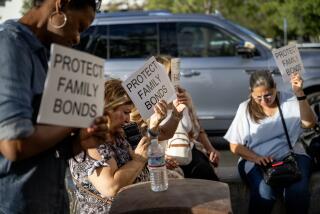Traditional Family Nearly the Exception, Census Finds
- Share via
WASHINGTON — The conventional model of American family life--a married couple with kids and a stable home--is on the verge of becoming the exception rather than the rule, the U.S. Census Bureau reported Monday.
In a study certain to fuel the “family values” debate, Census Bureau statisticians said that only 50.8% of American children live in a traditional “nuclear” family. They define a nuclear family as one where both biological parents are present and all children were born after the marriage. It excludes households with single or divorced parents and other adults or children.
The study is based on 1991 data and does not contain comparable figures for previous or more recent years. But it squares with other reports in recent years that show a decline in the number of traditional families.
Census officials said that the decline reflects powerful societal trends that cannot be easily reversed: gradual migration from rural communities to cities and suburbs, growing ranks of working mothers, declining church and community influences, expanded assistance to poor households and greater tolerance of divorce and single parenting.
“With more and more women bearing children out of wedlock, along with high divorce rates, more children than ever are spending at least part of their childhoods in single-parent families or other alternative family situations,” said Stacy Furukawa, author of the report.
The findings are likely to provide ammunition for political candidates and social critics who argue that policies and practices that undermine “family values” contribute to many of society’s ills, including crime and broken homes.
“It’s the kind of thing that can have a substantial impact on the political situation,” said Ross Baker, professor of political science at Rutgers University. “It tells us that the glass is half empty, confirming the popular suspicion that America is going to hell in a handbasket.”
The new report did not cite corresponding data from earlier or later years. However, its findings are similar to an earlier, little-noticed analysis of census data that clearly showed a steep decline in the percentage of children living in traditional nuclear families over the last two decades.
Donald Hernandez, the Census Bureau official who published a book, “America’s Children,” on the subject, found that the number of children who lived in nuclear families was 57% in 1980 and 66% in 1970. But he reported that the number was 51% in 1988, virtually identical to the 1991 census figure, which could indicate a leveling of the decline.
The decline in the staying power of the nuclear family, he said, is the combined result of several different sweeping demographic changes over the century.
During the first half of the century, many families migrated from family farms to urban areas, where both parents and their offspring had worked together to keep the family afloat financially. There was also an exodus from close-knit communities and small towns, where social pressure was a great deterrent to divorce or bearing children out of wedlock.
Once in the city, people had greater anonymity and there was less societal pressure to remain married. Also, starting in the 1960s, more women were entering the labor market, and leaving unwanted marriages became easier for them financially.
“There are very powerful and strong forces leading to the increase of divorce and the change away from the traditional family,” said Hernandez, who is the chief of the Census Bureau’s marriage and family statistics branch. “That does not mean public policy cannot do something to turn around that trend. But they would have to be very powerful policies to have any impact.”
The percentage of children living in nuclear families varies greatly by race and ethnic group. Fifty-six percent of white children lived in “traditional nuclear families,” while 26% of African American and 38% of Latino children did.
About 15% of all children lived in “blended” families, with a stepparent and/or stepchildren.
Overall, 12.5% of children lived in extended family situations, where at least one additional adult--a grandparent, other relative or a boarder--lived in the household.
Children in one-parent families were four times more likely to live in an extended family than children living with two parents. Only 7% of the children living with both parents had additional adults in their households while 30% of children living with a single parent did.
Latino children were most likely to live in extended families. A quarter of all Latino children, 20% of black children and 10% of white children lived in such households.
Poverty, unemployment and the shortage of affordable housing, as well as cultural traditions, all played a role in influencing whether additional adults live in one household with a nuclear family, Furukawa said.
Fully one in four children lives with a single parent, according to the report. One-half of all black children, nearly one third of Latino children and one-fifth of white children lived with a single parent, according to the report.
One-fifth of the children living with a single mother had an adult male, related or unrelated, living in their household. About two-fifths of the children living with a single father had an adult female, related or unrelated, living with them.
Household Structure
One out of two children lived in a nuclear family, which is defined in the study as composed solely of both biological parents and full brothers and sisters.
Children living in nuclear family Total: 50.8% White: 56.4% Black: 25.9% Latino: 37.8% ***
Living with at least one grandparent Total: 7.2% White: 5.3% Black: 14.9% Latino: 12.1% ***
Living with mother only Total: 21.2% White: 16.4% Black: 48.7% Latino: 28.5% ***
Living with father only Total: 2.7% White: 2.7% Black: 2.4% Latino: 2.6% Source: Census Bureau’s Survey of Income and Program Participation, based on national-level estimates of children under 18, for the period June through September, 1991.
More to Read
Get the L.A. Times Politics newsletter
Deeply reported insights into legislation, politics and policy from Sacramento, Washington and beyond. In your inbox twice per week.
You may occasionally receive promotional content from the Los Angeles Times.










